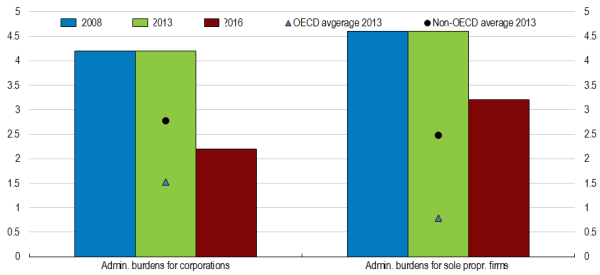Firming institutional capital as expected driver of entrepreneurship and innovation
Notwithstanding rapid productivity convergence and impressive build-up of infrastructure and knowledge over the past couple of decades, it has not been until very recently that the institutional environment is targeted to better suit the transition towards an entrepreneurial and innovative economy. A path-breaking achievement in this direction is the removal of barriers to entrepreneurship started during the current government. Since 2013, administrative procedures have been simplified and licencing requirements reduced. The OECD PMR indicators can capture these changes and show significant reduction of such burden both on corporations and sole proprietor firms (Figure 3). Benefiting from reduced barriers to set up businesses, the past year or so saw an unprecedented surge in new company registration, in particular in services.
Figure 3. Barriers to entrepreneurship are falling rapidly
Barriers to entrepreneurship component of the Product Market Regulatory indicator, 2013 and 2016
 |
|
The administrative burden on start-ups sub-component of the OECD Product Market Regulation indicator captures changes for corporations and sole proprietorships.[Source from OECD Product Market Regulation database.] |
Once a favourable environment is established for enterprise creation, it is also crucial to ensure that zombie companies do not take up resources and through efficient mechanisms exit the market. Such “creative destruction” is the driver of productivity growth by giving space to new ideas, new products and new processes.